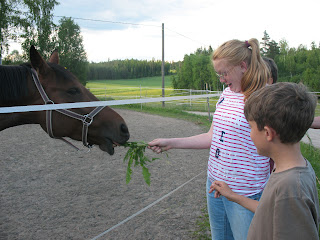





Pic 1 Lars Erik with his semi tractor trailer
Pic 2 Ship leaving haarbor for Germany
Pic 3 Water carousel at beach in Hango
Pic 4 Austin with WWII missile
Pic 5 Barbed wire boundary at museum
Pic 6 large cannon from WWII
Today, we set off to see the southernmost city in Finland called Hango which is a tourist town in the summer with miles and miles of coastline. When we arrived, we took a tour of the harbor where Lars Erik who drives an 18 wheeler picks up trailers to carry all over. He drives an average of 3000 km a week or about 170,000 km per year. We saw a tanker leaving the harbor going to Germany to pick up another load! After that we took a driving tour of the area and stopped at a local beach to let the kids swim. Of course today was overcast and cool and then on the beach it was windy. So needless to say, they did not stay in long, but Austin was the first in! They had a rope carousel out in the water that would swing you around when you caught a rope. Since Austin was the right size, it whipped him all around through the air while it only dragged the other kids through the water! After that, we stopped at a restaurant that Lars Erik knew had good food--a truck stop--and it was good!
Before we got to Hango, though, we stopped at a museum that was part of the Winter War with Russia in 1939-40 and led to Finland's cooperation with the Germans against Russia in WWII. The original foxholes, trenches and barracks are still there along with some mines and cannons. Just over the rise of land was the boundary line between Finland and Russia devised in the treaty to end the war. Though the Finns were poorly prepared for war in manpower and equipment, as I teach in my history classes: When fighting for home, family, and land, the home team has a definite advantage and determination to keep and preserve what is theirs. And in this case, too, Finland prevailed.
Though the US has used the draft system and young men must still register for the draft, it is mandatory in Finland that young men must serve in the army for 6, 8, or 12 months to learn an army job in the event a large army is needed for the country's defense. If the time is not served, the young men must serve an equal time in jail or must leave the country. They are not eligible to receive any more benefits as citizens (which are many) if they do not serve the time. Then as time goes on, a few weeks may be required for additional training. Lars Erik, who is trained in large cannons, will train for his last time for a few days in August.
Our wonderful time in Ekanas is over. Tomorrow we leave for Helsinki for a couple of days before we return home on Tuesday, June 30. Where has the time gone?



















































